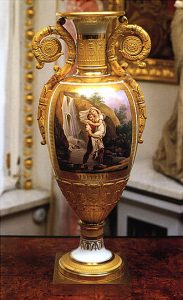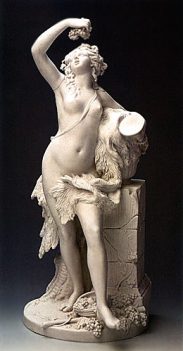Lomonosov Porcelain Factory was founded in 1744 in Saint Petersburg by Empress Elizabeth, daughter of Peter the Great. It became thus the first porcelain manufactory in Russia and the third in Europe.
In 1752 talented Russian scientist Dmitry Vinogradov (1720–1758) discovered the secret of fabricating “while gold”. For the first time in ceramic history, he put together a scientific description of porcelain manufacturing, close to the most recent notions in ceramic chemistry. Porcelain, created by Dmitry Vinogradov, in its quality was as good as the Saxon porcelain, and its body prepared out of the local raw materials approached Chinese.
In 1756, when Vinogradov succeeded to construct a big kiln, items of a bigger size began to be produced. It is at this period that the first dinner set, “Own”, was created, it belonged to the Empress personally. Starting 1750s porcelain “dolls” – figurines of people and animals started to be produced. In spite of an increase in porcelain manufacturing, the pieces still were adorable only for a limited circle of the confidants.
Personal table set.
The end of 18th century was the period of the golden age for Russian porcelain, and the Imperial Manufactory became one of the leading in Europe. The peak of the glory of the Imperial Manufactory was put up by the luxurious service ensembles ordered by Catherine II— «Arabesque», «Yacht», «Cabinet», that count up to one thousand pieces. Contemporaries valued «Catherine’s porcelain» and perceived it in the line with paintings and sculpture of famous masters. «Nowadays’ porcelain,— noted I. G. Gregory, a well-known ethnographer and a traveler in his description of Saint Petersburg in 1794,— is beautiful both in terms of body’s purity and in terms of taste and composition, shape and painting. In the shops, one can see big sized and with the highest mastery manufactured pieces.
Pole and Virginia.
Beginning with the era of Alexander I (1801–1825), and until the end of the 1860s, vases occupied a special place in the factory production. Gold became one of the favorite decorative materials. Painting developed mainly battle and landscape genres.
August Spiess, sculptor. Figure of Bacchante.
In the reign of Nicholas I (1825-1855), the high technical capabilities of the Imperial Porcelain Factory enabled it to produce elaborate items to decorate the interiors of palaces: monumental vases, mirrors in porcelain frames and paintings on sheets of porcelain. Particularly interesting are the biscuit bouquet made by Piotr Ivanov, a door with porcelain plaques, produced in 1844, and also an artistically remarkable collection of porcelain Easter eggs.
Nicholas’s porcelain was featured mainly by its virtuous painting. The vases bared classical canvases of old masters reproduced on them. Those masterpieces of Leonardo da Vinci, Raphael, Titian, Correggio, Murillo and others mainly from the Hermitage’s collection. Copies pictured precisely true to their originals amazed everyone by its vivid colour-grade and brilliance as if being a reflection of masters. Portrait painting, miniature and iconic painting on vases and plaques progressed greatly, too. Factory’s leading position in painting on porcelain was highly attested by the certificates achieved at the World Exhibitions.
During the reign of the last Russian Emperor Nicholas II (1894 – 1917) the factory ascended its peak in technique and technology. That success was achieved by innovations in the technique of the previous period. The richness of artistic technology become the factory’s pride, and later, during the First World War, the factory proved a base for new industries of chemical and electrical engineering porcelain.
In the middle of 1910s, the factory established a relationship with the artists of a group “World of Art” – K. Somov, E. Lancere, S. Chekhonin, who contributed the establishment of neoclassical style.
Porcelain of the 1920’s was influenced by political events of the time – October Socialist Revolution. In 1918 the factory was nationalized. And as a State property, the factory was given to the charge of the National commissariat of education, that gave a task to turn the former court factory into “a testing ceramic laboratory of republican significance” producing “an eminent propaganda porcelain – revolutionary in its idea, perfect in its shape and technically flawless”. factory’s art policy was an element of Lenin’s plan of monumental propaganda with its precisely determined principles of the art of porcelain.
Porcelain of the 1920’s is one of the most interesting and amazing chapters in the history of decorative and applied art. In a perfect artistic form and historically truly it reflected the spirit of the first post-revolutionary years. Under the direction of S. Chekhonin, who later would be called “a master of Soviet Empire style”, many talented artists such as A.
Schekotikhina-Pototskaya, N. Daniko, V. Kuznetsov, M. Lebedeva, M. Adamovich and others created propaganda porcelain. Porcelain of the 1920’s also evokes the names of B. Kustodiev, K. Petrov-Vodkin, M. Dobuzhinskiy and the world-famous names K. Malevich and V. Kandinskiy.
Before the revolution, porcelain was an embodiment of exquisite, refined art, accessible to a limited society only. Now it became the first and the brightest symbol of revolution. And at the same time, it became a kind soil for the conception of a new art trend – suprematism.
During the pre-war period of socialist construction in Russian porcelain, in 1930’s were a time of birth of the Soviet culture. The first creative artistic laboratory was founded at the Leningrad Porcelain Factory. Under the direction of N.Suetin, an apprentice of K.Malevich, the art group created a new style of Soviet porcelain consonant to ”the socialist everyday life”. N.Suetin, as a talented artist and manager, blended suprematism with the decorative trend of the “World of Art” and a realistic projection of nature. Individual creative characters of A.Vorobyovskiy, I.Riznich, M.Mokh, T.Bezpalova, L.Protopopova, L.Black, A.Yatskevich, S.Yakovleva, and others, for many years ahead, determined the personality of Leningrad porcelain: purity and softness of its forms, elicited whiteness of the material, precise images of patterns and rich colors.
Post-war porcelain.
After the war, early-late 1960’s, Russian art turned again to the mottoes of the 1920’s: “Art – into everyday life” and “Art – into production,” and the style of simplicity, constructive laconism of geometrical volumes. Reconstruction of the factory and introduction of the new technology of porcelain production allowed a considerable increase in numbers and variety of output. The technology of mass production of bone china was a huge boost for the factory growth, and a new line of products with egg-shell, snow-white and translucent porcelain has begun.
Russian porcelain today.
Russian porcelain today is a mixture of classic and modern styles. It is in a constant state of renewal with the huge variety of product lines.









